How To Make A Soup From Anything
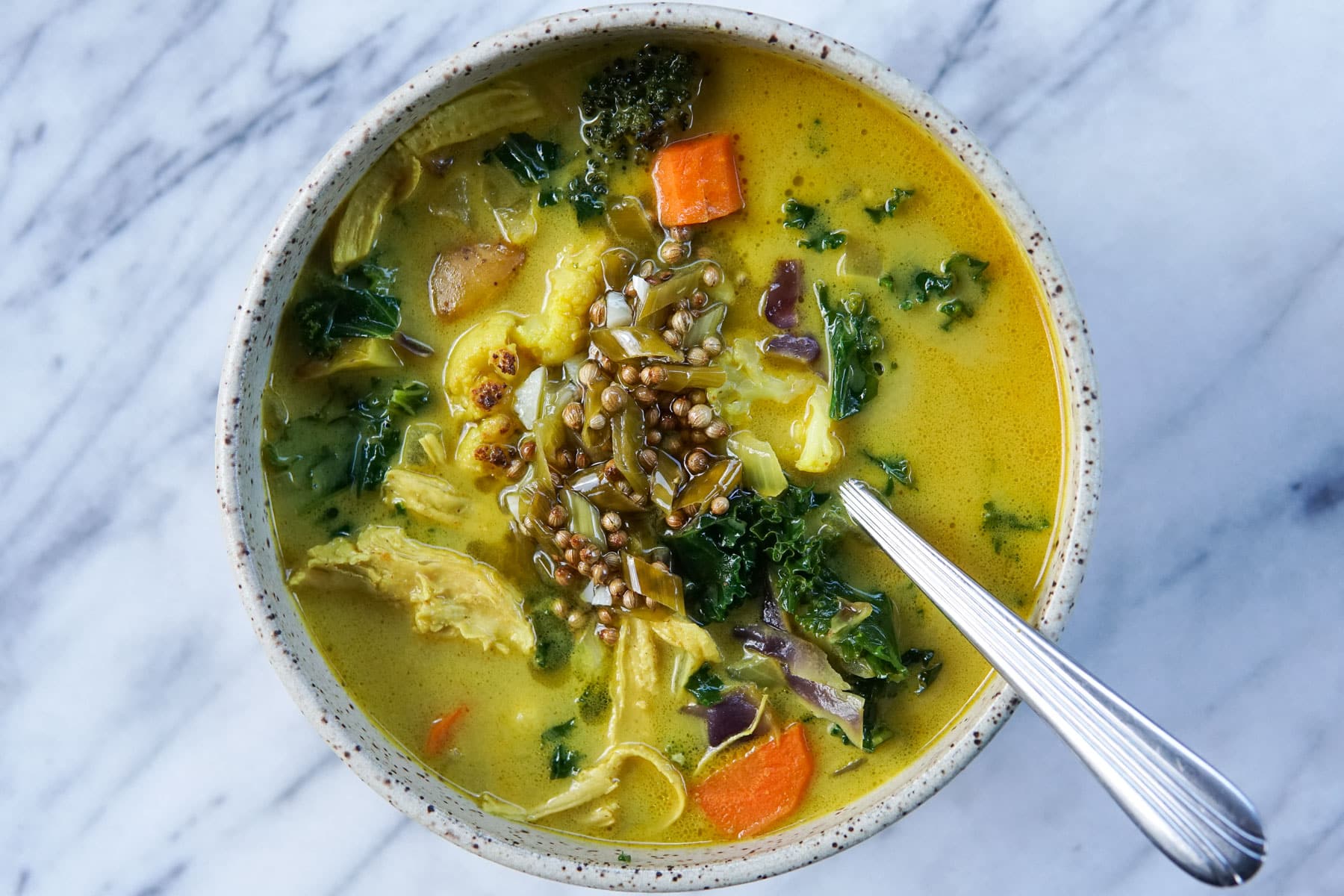
Soups are one of my favorite recipes to develop and eat this time of year because they are so adaptable, come together in one pot, and are so incredibly comforting! They’re also an amazing way to use up leftovers. As long as you have aromatics (onion, carrot, +/or celery), veggies, and protein – you can […]
Soups are one of my favorite recipes to develop and eat this time of year because they are so adaptable, come together in one pot, and are so incredibly comforting! They’re also an amazing way to use up leftovers. As long as you have aromatics (onion, carrot, +/or celery), veggies, and protein – you can […]
Soups are one of my favorite recipes to develop and eat this time of year because they are so adaptable, come together in one pot, and are so incredibly comforting!
They’re also an amazing way to use up leftovers. As long as you have aromatics (onion, carrot, +/or celery), veggies, and protein – you can make a delicious soup! Plus is fun to experiment with different spices and flavors.
In a recent member Q&A, someone asked: “Will you please provide a basic soup recipe to follow that can be adapted depending on what you have?” So I remembered that I had created a basic soup formula from our January 2022 Cooking Class that I wanted to share with everyone ????
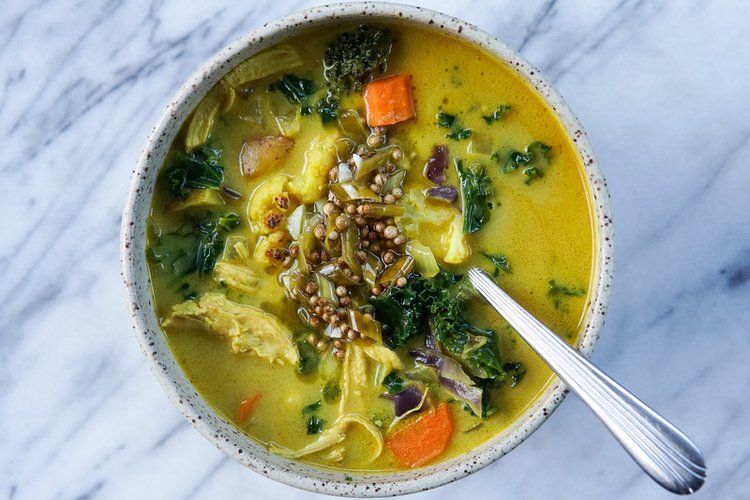
Basic Soup Formula
(Serves 4)
Ingredients:
2 tbsp olive oil
1 onion, chopped (add or sub-chopped carrot and/or celery)
Kosher salt
Flavor options: garlic, ginger, 2-4 tbsp tomato paste, 1-2 tbsp ground spices, thai curry paste…
6 cups liquid (use water, broth, or a combination of water/broth with coconut milk to make it creamy)
1 cup grain or 2-3 cups starchy vegetable (jasmine rice, quinoa, farro, short grain brown rice, pasta OR potato/root veggies)
4 cups chopped veggies
2 cups protein (chicken, lentils, beans, tofu)*
1-2 tbsp soy sauce or tamari
3-5 cups chopped greens (kale, spinach, chard)
1-2 tbsp acid (lime juice, lemon juice, vinegar)
Topping ideas: fresh herbs, yogurt, soft egg, olive oil, black pepper, a squeeze of lemon or lime
*In general, you’ll want about 1 lb of raw meat or about 2 cups of cooked meat. Or 1 cup dried lentils, 2 (15 oz) cans beans, or 1 block tofu (see notes on next page).
Instructions:
In a large pot over medium heat, add your oil, aromatics, and ½ teaspoon salt. Cook, stirring occasionally, for about 3-5 minutes, or until softened (the longer the better!).
Add in your flavorings and cook for about 1 minute, stirring often (you want to toast/bloom your spices or pastes in the oil). Stir in the liquid, grain, or starchy veg, chopped veg, protein, soy sauce, and remaining ½ – 1 teaspoon salt. Bring to a boil over high heat, then reduce the heat to low and simmer for 15-30 minutes (or until your grains and protein are cooked through).
Stir in your greens and let cook for 1-2 minutes to wilt down. Remove from heat and stir in your acid. If you want to add the miso paste, now is the time. If you want your soup to be half pureed for a thicker broth – do it now! Once you’re done with all of that, make sure to taste and add either or both of these two things if it tastes flat: salt (or soy sauce) or acid (lemon or lime).
Serve it up topped with your desired toppings.
Notes on Soup Formula
Aromatics: you always want to start soups by cooking your aromatics (onion, carrot, celery). This adds a lot of flavor to your water-based broth. You could also use the white and light green parts of scallions in place of or in addition to the onion.
Flavorings: This is where you choose which flavor direction you want your soup to go in. You want to add these in after the aromatics are softened and “toast” them in the oil just for 1 minute or so to boost the flavor. Some examples:
- Chopped garlic + curry powder
- Grated ginger + miso paste (add miso at the end, see note below)
- Chopped garlic, smoked paprika, cumin
- Thai curry paste
Liquid: I pretty much always use water as my main liquid and coconut milk if I want to go a Thai or Indian route. You could also use broth if you have some.
Salt: don’t be afraid of adding a good amount of salt. Since we’re using water and not broth which usually has salt in it, you’ll likely need to add anywhere between 1-2 teaspoons of kosher salt total (depending on how much soy sauce or other salty things you’re adding).
Grain: you always want to have something starchy in a soup to make it more filling and hearty. This can either be a starchy veg like potatoes or winter squash or a grain like rice, farro, or quinoa. For starchy veg, you’ll want about 2 cups. For grains, you’ll want ½-1 cup uncooked.
Veggies: chop up any odds and ends you have lying around into similar-sized pieces. For the veggies, keep in mind how long they take to cook. For example, if you’re adding potatoes and green beans – add the potatoes in with the water and add the green beans towards the end so they don’t get too mushy.
Protein: this is totally up to you. Keep it vegetarian and add in 1 cup of dried lentils, a couple of cans of drained beans, or cubed tofu. Make it meaty and add 1 lb chicken thighs or breasts and just shred it up after they are cooked. You could also add in ground meat after you cook your aromatics and before you add in your flavorings. If you have leftover cooked meat, just stir it in towards the end to warm it up.
Greens: these are optional, but a nice addition towards the end of the cooking process to add bright green color and some extra veg.
Acid and herbs: finishing your soup off with a squeeze of lemon or lime really balances out the richness or saltiness of the soup. Topping the soup with fresh herbs really freshens it up. This is especially helpful when reheating the leftover soup.
Umami boosters: these are ingredients you can add to soups to make the broth taste richer and more full-bodied.
- Tomato paste: add this in the beginning with the flavorings because you want to cook out some of that raw tomato flavor (~ 2-4 tbsp)
- Soy sauce: add this in with the water and/or at the end, to taste (~ 1-4 tbsp)
- Fish sauce: same as soy sauce, but less quantity (~ 1 tbsp)
- Miso paste: Add this at the end once the heat is turned off. Mix it in a bowl with some of the hot liquid and stir it back into the soup. (~ ¼ cup)
- Mushrooms: add these in with the water, veggies, etc… (~ 1-3 cups chopped)
Soup Recipes
This Indian Curry Chicken Soup with Coriander Oil (pictured above) was the recipe we made for the Cooking Class that uses the soup formula!
You can find more Cooking Club soup recipes below.

Soupy Rice with Gingery Pork + Veggies
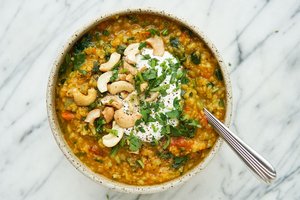
Spiced Tomato Lentil + Rice Soup
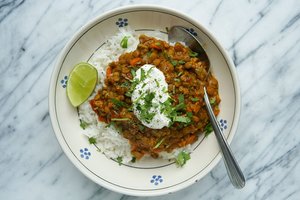
Instant Pot Turkey Lentil Curry
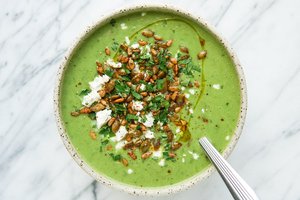


leave your comments!